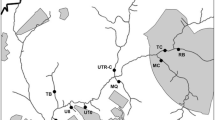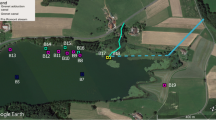Abstract
Various natural environments have been examined for the presence of antibiotic-resistant bacteria and/or novel resistance mechanisms, but little is known about resistance in the terrestrial deep subsurface. This study examined two deep environments that differ in their known period of isolation from surface environments and the bacteria therein. One hundred fifty-four strains of bacteria were isolated from sediments located 170–259 m below land surface at the US Department of Energy Savannah River Site (SRS) in South Carolina and Hanford Site (HS) in Washington. Analyses of 16S rRNA gene sequences showed that both sets of strains were phylogenetically diverse and could be assigned to several genera in three to four phyla. All of the strains were screened for resistance to 13 antibiotics by plating on selective media and 90% were resistant to at least one antibiotic. Eighty-six percent of the SRS and 62% of the HS strains were resistant to more than one antibiotic. Resistance to nalidixic acid, mupirocin, or ampicillin was noted most frequently. The results indicate that antibiotic resistance is common among subsurface bacteria. The somewhat higher frequencies of resistance and multiple resistance at the SRS may, in part, be due to recent surface influence, such as exposure to antibiotics used in agriculture. However, the HS strains have never been exposed to anthropogenic antibiotics but still had a reasonably high frequency of resistance. Given their long period of isolation from surface influences, it is possible that they possess some novel antibiotic resistance genes and/or resistance mechanisms.



Similar content being viewed by others
References
Alonso A, Sanchez P, Martinez JL (2001) Environmental selection of antibiotic resistance genes. Environ Microbiol 3:1–9
Aminov RI, Garrigues-Jeanjean N, Mackie RI (2001) Molecular ecology of tetracycline resistance: development and validation of primers for detection of tetracycline resistance genes encoding ribosomal protection proteins. Appl Environ Microbiol 67:22–32
Aminov RI, Mackie RI (2007) Evolution and ecology of antibiotic resistance genes. FEMS Microbiol Lett 271:147–161
Amy PS, Haldeman DL (1997) The microbiology of the terrestrial deep subsurface. Lewis, New York, NY
Ash RJ, Mauck B, Morgan M (2002) Antibiotic resistance of Gram-negative bacteria in rivers, United States. Emerg Infect Dis 8:713–716
Balkwill DL, Fredrickson JK, Thomas JM (1989) Vertical and horizontal variations in the physiological diversity of the aerobic chemoheterotrophic bacterial microflora in deep Southeast Coastal Plain subsurface sediments. Appl Environ Microbiol 55:1058–1065
Balkwill DL, Reeves RH, Drake GR, Reeves JY, Crocker FH, King MB, Boone DR (1997) Phylogenetic characterization of bacteria in the Subsurface Microbial Culture Collection. FEMS Microbiol Rev 20:201–216
Baquero F, Negri MC, Morosini MI, Blazquez J (1998) Antibiotic-selective environments. Clin Infect Dis 27(Suppl 1):S5–11
Boxall AB, Kolpin DW, Halling-Sorensen B, Tolls J (2003) Are veterinary medicines causing environmental risks? Environ Sci Technol 37:286–294
Chapelle F (1993) Ground-water microbiology and geochemistry. Wiley, New York, NY
Chopra I, Roberts M (2001) Tetracycline antibiotics: mode of action, applications, molecular biology, and epidemiology of bacterial resistance. Microbiol Mol Biol Rev 65:232–260
CLSI (2005) Performance standards for antimicrobial susceptibility testing. Fifteenth informational supplement, CLSI document M100-S15 ed. Clinical and Laboratory Standards Institute, Wayne, PA
Cole JR, Chai B, Farris RJ, Wang Q, Kulam-Syed-Mohideen AS, McGarrell DM, Bandela AM, Cardenas E, Garrity GM, Tiedje JM (2007) The ribosomal database project (RDP-II): introducing myRDP space and quality controlled public data. Nucleic Acids Res 35(Database issue):D169–D172
Coombs JM, Barkay T (2004) Molecular evidence for the evolution of metal homeostasis genes by lateral gene transfer in bacteria from the deep terrestrial subsurface. Appl Environ Microbiol 70:1698–1707
Crocker FH, Fredrickson JK, White DC, Ringelberg DB, Balkwill DL (2000) Phylogenetic and physiological diversity of Arthrobacter strains isolated from unconsolidated subsurface sediments. Microbiology 146:1295–1310
D’Costa VM, Griffiths E, Wright GD (2007) Expanding the soil antibiotic resistome: exploring environmental diversity. Curr Opin Microbiol 10:481–489
D’Costa VM, McGrann KM, Hughes DW, Wright GD (2006) Sampling the antibiotic resistome. Science 311:374–377
Davison J (1999) Genetic exchange between bacteria in the environment. Plasmid 42:73–91
De Souza MJ, Nair S, Loka Bharathi PA, Chandramohan D (2006) Metal and antibiotic-resistance in psychrotrophic bacteria from antarctic marine waters. Ecotoxicology 15:379–384
Dhakephalkar PK, Chopade BA (1994) High levels of multiple metal resistance and its correlation to antibiotic resistance in environmental isolates of Acinetobacter. Biometals 7:67–74
Drake GR, DeFlaun MF, Streger S, Levy SB, Bueker CL, Balkwill DL (1999) Widespread antibiotic resistance among bacteria isolated from subsurface environments, Abstr. 4th International Symposium on Subsurface Microbiology, Vail, CO, USA
Ferreira da Silva M, Vaz-Moreira I, Gonzalez-Pajuelo M, Nunes OC, Manaia CM (2007) Antimicrobial resistance patterns in Enterobacteriaceae isolated from an urban wastewater treatment plant. FEMS Microbiol Ecol 60:166–176
Fevre C, Jbel M, Passet V, Weill FX, Grimont PA, Brisse S (2005) Six groups of the OXY beta-Lactamase evolved over millions of years in Klebsiella oxytoca. Antimicrob Agents Chemother 49:3453–3462
Fredrickson JK, Balkwill DL (2006) Geomicrobial processes and biodiversity in the deep terrestrial subsurface. Geomicrobiol J 23:345–356
Fredrickson JK, Fletcher M (2001) Subsurface microbiology. Wiley, New York, NY
Fredrickson JK, Garland TR, Hicks JM, Thomas JM, Li SW, McFadden KM (1989) Lithotrophic and heterotrophic bacteria in deep subsurface sediments and their relation to sediment properties. Geomicrobiol J 7:53–65
Fredrickson JK, Hicks RJ, Li SW, Brockman FJ (1988) Plasmid incidence in bacteria from deep subsurface sediments. Appl Environ Microbiol 54:2916–2923
Ghiorse WC (1989) Special issue on deep subsurface microbiology. Geomicrobiol J 7:1–136
Ghiorse WC, Wilson JT (1988) Microbial ecology of the terrestrial subsurface. Adv Appl Microbiol 33:107–172
GlaxoSmithKline (2004) Bactroban Cream: Prescribing Information. Research Triangle Park, NC.
Hall BG, Barlow M (2004) Evolution of the serine beta-lactamases: past, present and future. Drug Resist Updat 7:111–123
Hall JA, Mailloux BJ, Onstott TC, Scheibe TD, Fuller ME, Dong H, DeFlaun MF (2005) Physical versus chemical effects on bacterial and bromide transport as determined from on site sediment column pulse experiments. J Contam Hydrol 76:295–314
Jacobs L, Chenia HY (2007) Characterization of integrons and tetracycline resistance determinants in Aeromonas spp. isolated from South African aquaculture systems. Int J Food Microbiol 114:295–306
Kieft TL, Fredrickson JK, McKinley JP, Bjornstad BN, Rawson SA, Phelps TJ, Brockman FJ, Pfiffner SM (1995) Microbiological comparisons within and across contiguous lacustrine, paleosol, and fluvial subsurface sediments. Appl Environ Microbiol 61:749–757
Kobayashi T, Nonaka L, Maruyama F, Suzuki S (2007) Molecular evidence for the ancient origin of the ribosomal protection protein that mediates tetracycline resistance in bacteria. J Mol Evol 65:228–235
Lane D (1991) 16S/23S rRNA sequencing. In: Stackebrandt E, Goodfellow M (eds) Nucleic acid techniques in bacterial systematics. Wiley, New York, NY, pp 131–175
Levy SB (2002) The 2000 Garrod lecture. Factors impacting on the problem of antibiotic resistance. J Antimicrob Chemother 49:25–30
Levy SB, Marshall B (2004) Antibacterial resistance worldwide: causes, challenges and responses. Nat Med 10:S122–S129
Lima-Bittencourt CI, Cursino L, Goncalves-Dornelas H, Pontes DS, Nardi RM, Callisto M, Chartone-Souza E, Nascimento AM (2007) Multiple antimicrobial resistance in Enterobacteriaceae isolates from pristine freshwater. Genet Mol Res 6:510–521
Lorenz MG, Wackernagel W (1994) Bacterial gene transfer by natural genetic transformation in the environment. Microbiol Rev 58:563–602
Maiden MC (1998) Horizontal genetic exchange, evolution, and spread of antibiotic resistance in bacteria. Clin Infect Dis 27(Suppl 1):S12–S20
Martinez RJ, Wang Y, Raimondo MA, Coombs JM, Barkay T, Sobecky PA (2006) Horizontal gene transfer of PIB-type ATPases among bacteria isolated from radionuclide- and metal-contaminated subsurface soils. Appl Environ Microbiol 72:3111–3118
Martins da Costa PM, Vaz-Pires PM, Bernardo FM (2006) Antibiotic resistance of Enterococcus spp. isolated from wastewater and sludge of poultry slaughterhouses. J Environ Sci Heal B 41:1393–1403
McKeon DM, Calabrese JP, Bissonnette GK (1995) Antibiotic resistant Gram-negative bacteria in rural groundwater supplies. Water Res 29:1902–1908
McKinley IG, Hagenlocher I, Alexander WR, Schwyn B (1997) Microbiology in nuclear waste disposal: interfaces and reaction fronts. FEMS Microbiol Rev 20:545–556
Mudryk ZJ (2005) Occurrence and distribution antibiotic resistance of heterotrophic bacteria isolated from a marine beach. Mar Pollut Bull 50:80–86
Neela FA, Nonaka L, Suzuki S (2007) The diversity of multi-drug resistance profiles in tetracycline-resistant Vibrio species isolated from coastal sediments and seawater. J Microbiol 45:64–68
Nikaido H (1998) Antibiotic resistance caused by gram-negative multidrug efflux pumps. Clin Infect Dis 27(Suppl 1):S32–S41
Nwosu VC (2001) Antibiotic resistance with particular reference to soil microorganisms. Res Microbiol 152:421–430
Patterson AJ, Colangeli R, Spigaglia P, Scott KP (2007) Distribution of specific tetracycline and erythromycin resistance genes in environmental samples assessed by macroarray detection. Environ Microbiol 9:703–715
Phelps TJ, Fliermans CB, Garland TR, Pfiffner SM, White DC (1989) Methods for recovery of deep terrestrial subsurface sediments for microbiological studies. J Microbiol Meth 9:267–279
Quinn JP (1998) Clinical problems posed by multiresistant nonfermenting Gram-negative pathogens. Clin Infect Dis 27(Suppl 1):S117–S124
Riesenfeld CS, Schloss PD, Handelsman J (2004) Metagenomics: genomic analysis of microbial communities. Annu Rev Genet 38:525–552
Russell BF, Phelps TJ, Griffin WT, Sargent KA (1992) Procedures for sampling deep subsurface microbial communities in unconcolidated sediments. Ground Water Monit R 12:96–104
Sabry SA, Ghozlan HA, Abou-Zeid DM (1997) Metal tolerance and antibiotic resistance patterns of a bacterial population isolated from sea water. J Appl Microbiol 82:245–252
Saier MH Jr, Paulsen IT, Sliwinski MK, Pao SS, Skurray RA, Nikaido H (1998) Evolutionary origins of multidrug and drug-specific efflux pumps in bacteria. Faseb J 12:265–274
Salyers A, Shoemaker NB (2006) Reservoirs of antibiotic resistance genes. Anim Biotechnol 17:137–146
Salyers AA, Gupta A, Wang Y (2004) Human intestinal bacteria as reservoirs for antibiotic resistance genes. Trends Microbiol 12:412–416
Sargent KA, Fliermans CB (1989) Geology and hydrology of the deep subsurface microbiology sampling sites at the Savannah River Plant, South Carolina. Geomicrobiol J 7:3–13
Schmitt H, Stoob K, Hamscher G, Smit E, Seinen W (2006) Tetracyclines and tetracycline resistance in agricultural soils: microcosm and field studies. Microb Ecol 51:267–276
Sinclair JL, Ghiorse WC (1989) Distribution of aerobic bacteria, protozoa, algae, and fungi in deep subsurface sediments. Geomicrobiol J 7:15–31
Smets BF, Morrow JB, Arango Pinedo C (2003) Plasmid introduction in metal-stressed, subsurface-derived microcosms: plasmid fate and community response. Appl Environ Microbiol. 69:4087–4097
Song JS, Jeon JH, Lee JH, Jeong SH, Jeong BC, Kim SJ, Lee JH, Lee SH (2005) Molecular characterization of TEM-type beta-lactamases identified in cold-seep sediments of Edison Seamount (south of Lihir Island, Papua New Guinea). J Microbiol 43:172–178
Summers AO (2006) Genetic linkage and horizontal gene transfer, the roots of the antibiotic multi-resistance problem. Anim Biotechnol 17:125–135
Swofford D (1989–2002) PAUP, Phylogenetic Analysis Using Parsimony, 4.0 Beta edn. Sinauer, Sunderland, MA
Séveno NA, Kallifidas D, Smalla K, Dirk van Elsas J, Collard JM, Karagouni AD, Wellington EMH (2002) Occurrence and reservoirs of antibiotic resistance genes in the environment. Rev Med Microbiol 13:15–27
van Waasbergen LG, Balkwill DL, Crocker FH, Bjornstad BN, Miller RV (2000) Genetic diversity among Arthrobacter species collected across a heterogeneous series of terrestrial deep-subsurface sediments as determined on the basis of 16S rRNA and recA gene sequences. Appl Environ Microbiol 66:3454–3463
Waters B, Davies J (1997) Amino acid variation in the GyrA subunit of bacteria potentially associated with natural resistance to fluoroquinolone antibiotics. Antimicrob Agents Chemother 41:2766–2769
Wise R (2004) The 2003 Garrod Lecture: The relentless rise of resistance? J Antimicrob Chemoth 54:306–310
Wright GD (2007) The antibiotic resistome: the nexus of chemical and genetic diversity. Nat Rev Microbiol 5:175–186
Acknowledgments
Part of this research was funded by a Leaders Educated to Make a Difference (LEAD) Grant to MGB from the Student Council on Research and Creativity (SCRC) at Florida State University. Other portions of this research were supported by the US Department of Energy Office of Science, Office of Biological and Environmental Research. We thank Jim Wilgenbusch in the Florida State University School of Computational Science for assistance with the phylogenetic analysis and modeling.
Author information
Authors and Affiliations
Corresponding author
Electronic supplementary material
Below is the link to the electronic supplementary material.
Supplemental Table 1
(DOC 148 KB)
Supplemental Table 2
(DOC 281 KB)
Supplemental Table 3
(DOC 111 KB)
Rights and permissions
About this article
Cite this article
Brown, M.G., Balkwill, D.L. Antibiotic Resistance in Bacteria Isolated from the Deep Terrestrial Subsurface. Microb Ecol 57, 484–493 (2009). https://doi.org/10.1007/s00248-008-9431-6
Received:
Revised:
Accepted:
Published:
Issue Date:
DOI: https://doi.org/10.1007/s00248-008-9431-6




